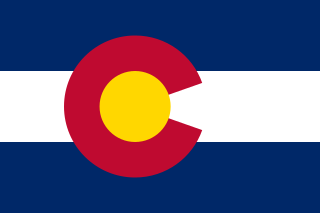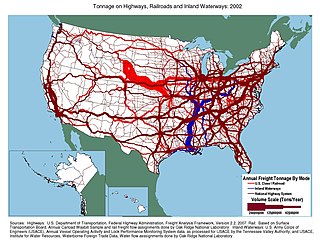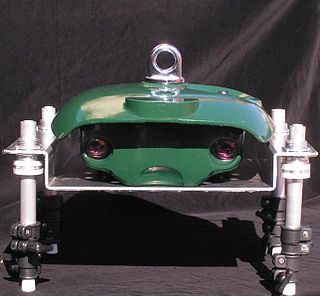Related Research Articles

Colorado is a state in the western United States encompassing most of the southern Rocky Mountains as well as the northeastern portion of the Colorado Plateau and the western edge of the Great Plains. It is the 8th most extensive and 21st most populous U.S. state. The estimated population of Colorado is 5,758,736 as of 2019, an increase of 14.5% since the 2010 United States Census.

Transportation in the United States is facilitated by road, air, rail, and waterways. The vast majority of passenger travel occurs by automobile for shorter distances, and airplane for longer distances. In descending order, most cargoes travel by railroad, truck, pipeline, or boat; air shipping is typically used only for perishables and premium express shipments. Transportation is the largest source of greenhouse gas emissions by the United States.

The United States Census Bureau (USCB), officially the Bureau of the Census, is a principal agency of the U.S. Federal Statistical System, responsible for producing data about the American people and economy. The Census Bureau is part of the U.S. Department of Commerce and its director is appointed by the President of the United States.

The United States Department of Transportation is a federal Cabinet department of the U.S. government concerned with transportation. It was established by an act of Congress on October 15, 1966, and began operation on April 1, 1967. It is governed by the United States Secretary of Transportation.
Interstate 69 (I-69) is an Interstate Highway in the United States currently consisting of ten disjointed parts with an original continuous segment from Indianapolis, Indiana, northeast to the Canadian border in Port Huron, Michigan, at 355.8 miles (572.6 km). The remaining separated segments are variously completed and posted or unposted sections of an extension southwest to the Mexican border in Texas. Of this extension—nicknamed the NAFTA Superhighway because it would help trade with Canada and Mexico spurred by the North American Free Trade Agreement—five pieces near Corpus Christi, Houston, northwestern Mississippi, Memphis, and Evansville have been built or upgraded and signposted as I-69. A sixth segment of I-69 through Kentucky utilizing that state's existing parkway system and a section of I-24 was established by federal legislation in 2008, but only a portion is signposted. This brings the total length to about 720 miles (1,160 km).

Travel behavior is the study of what people do over space, and how people use transport.
A travel survey is a survey of individual travel behavior. Most surveys collect information about an individual, their household, and a diary of their journeys on a given day.

Carpooling is the sharing of car journeys so that more than one person travels in a car, and prevents the need for others to have to drive to a location themselves.

State Route 91 (SR 91) is a major east–west state highway in the U.S. state of California that serves several regions of the Greater Los Angeles urban area. A freeway throughout its entire length, it officially runs from Vermont Avenue in Gardena, just west of the junction with the Harbor Freeway, east to Riverside at the junction with the Pomona and Moreno Valley freeways.

.us is the Internet country code top-level domain (ccTLD) for the United States. It was established in 1985. Registrants of .us domains must be U.S. citizens, residents, or organizations, or a foreign entity with a presence in the United States. Most registrants in the U.S. have registered for .com, .net, .org and other gTLDs, instead of .us, which has primarily been used by state and local governments, even though private entities may also register .us domains.

Los Angeles Union Station (LAUS) is the main railway station in Los Angeles, California, and the largest railroad passenger terminal in the Western United States. It opened in May 1939 as the Los Angeles Union Passenger Terminal, replacing La Grande Station and Central Station.

A metropolitan planning organization (MPO) is a federally mandated and federally funded transportation policy-making organization in the United States that is made up of representatives from local government and governmental transportation authorities. They were created to ensure regional cooperation in transportation planning. MPOs were introduced by the Federal-Aid Highway Act of 1962, which required the formation of an MPO for any urbanized area (UZA) with a population greater than 50,000. Federal funding for transportation projects and programs are channeled through this planning process. Congress created MPOs in order to ensure that existing and future expenditures of governmental funds for transportation projects and programs are based on a continuing, cooperative, and comprehensive (“3‑C”) planning process. Statewide and metropolitan transportation planning processes are governed by federal law. Transparency through public access to participation in the planning process and electronic publication of plans now is required by federal law. As of 2015, there are 408 MPOs in the United States.

The transportation system of New York City is a network of complex infrastructural systems. New York City, being the most populous city in the United States, has a transportation system which includes one of the largest subway systems in the world; the world's first mechanically ventilated vehicular tunnel; and an aerial tramway. New York City is also home to an extensive bus system in each of the five boroughs; citywide and Staten Island ferry systems; and numerous yellow taxis and boro taxis throughout the city. Private cars are less used compared to other cities in the rest of the United States.

The Texas Historical Commission is an agency dedicated to historic preservation within the state of Texas. It administers the National Register of Historic Places for sites in Texas.

The Infra-Red Traffic Logger, more commonly known simply by the acronym TIRTL, is a multi-purpose traffic sensor that can be used as a traffic counter, speed sensor, red light camera sensor, heavy vehicle tracker, overheight vehicle sensor, rail crossing sensor and network management system. The initial development of the device started in 1997 in conjunction with the New South Wales Roads and Traffic Authority & started commercial domestic and international sales in 2002. It is currently in use in sixteen countries.

Plans for high-speed rail in the United States date back to the High Speed Ground Transportation Act of 1965. Various state and federal proposals have followed. Despite being one of the world's first countries to get high-speed trains, it failed to spread. Definitions of what constitutes high-speed rail vary, including a range of speeds over 110 mph (180 km/h) and dedicated rail lines. Inter-city rail with top speeds between 90 and 125 mph is sometimes referred to in the United States as higher-speed rail.
The Texas Department of Transportation (TxDOT) is a governmental agency and its purpose is to "provide safe, effective, and efficient movement of people and goods" throughout the state. Though the public face of the agency is generally associated with maintenance of the state's immense highway system, the agency is also responsible for aviation in the state and overseeing public transportation systems.
Issues that affect water supply and sanitation in the United States include water scarcity, pollution, a backlog of investment, concerns about the affordability of water for the poorest, and a rapidly retiring workforce. Increased variability and intensity of rainfall as a result of climate change is expected to produce both more severe droughts and flooding, with potentially serious consequences for water supply and for pollution from combined sewer overflows. Droughts are likely to particularly affect the 66 percent of Americans whose communities depend on surface water. As for drinking water quality, there are concerns about disinfection by-products, lead, perchlorates, PFAS and pharmaceutical substances, but generally drinking water quality in the U.S. is good.

U.S. Route 281 (US 281) is a United States Numbered Highway that runs from the Mexican border in the Rio Grande Valley to the Canadian border near Dunseith, North Dakota. In the state of Texas, the highway is a major south–north corridor, connecting Brownsville to the Oklahoma state line at the Red River in Burkburnett. Several segments of U.S. 281 are concurrent with Interstate routes, including I-69C in the Rio Grande Valley, I-37 in San Antonio, and I-44 north of Wichita Falls.
Interstate 80 Business (BL-80) is an unofficial business loop of Interstate 80 (I-80) that is 2.26 miles (3.64 km) long and serves as the main street for the US cities of West Wendover, Nevada, and Wendover, Utah, along a roadway named Wendover Boulevard. Wendover Boulevard was originally part of U.S. Route 40 (US 40), which connected California to New Jersey via Nevada and Utah. A portion of the Nevada segment is concurrent with U.S. Route 93 Alternate (US 93 Alt.), and the entire portion in Utah is coterminous with Utah State Route 58 (SR-58). The Nevada Department of Transportation applied for the business loop designation in the early 1980s but the designation has never been approved; nevertheless, signs are posted in both states. Between July 1976 and 1993, BL-80 was concurrent with State Route 224 (SR 224) in Nevada.
References
- 1 2 Levinson, David (Summer 2007). "Metropolitan Travel Survey Archive" (PDF). TMIP Connection: The Traffic Model Improvement Program Newsletter. FHWA-HEP-07-032. College Station, Texas: Texas Transportation Institute and United States Department of Transportation: 6. Archived from the original (PDF) on April 16, 2009. Retrieved May 1, 2009. Archived from the original on May 1, 2009. "Properly archiving the travel surveys at a central location (with remote backups) safeguards the data against loss to calamities such as fires, earthquakes, floods, and terrorist attacks that have befallen earlier surveys."
- ↑ Levinson, David; Zofka, Ewa (2006). "The Metropolitan Travel Survey Archive: A Case Study in Archiving". In Stopher, Peter; Stecher, Cheryl (eds.). Travel Survey Methods (Google books). Elsevier and Emerald Group Publishing. pp. 223–238. ISBN 978-0-08-044662-2 . Retrieved May 1, 2009.
A related solution for archiving problems would be to create an International Travel Survey Archive (ITSA)
- ↑ Metropolitan Travel Survey Archive Available as Off-Site Archive in Urban Transportation Monitor Volume 19, No. 20, pp.1,9 Nov. 11, 2005 Archived 2008-12-23 at the Wayback Machine
- ↑ "Metropolitan Travel Survey Archive". Washington, DC: United States Department of Transportation. Archived from the original on May 2, 2009. Retrieved May 1, 2009.
The United States Department of Transportation’s Bureau of Transportation Statistics has funded a project at the University of Minnesota to develop a Metropolitan Travel Survey Archive to store, preserve, and make publicly available, via the internet, travel surveys conducted by metropolitan areas, states and localities.